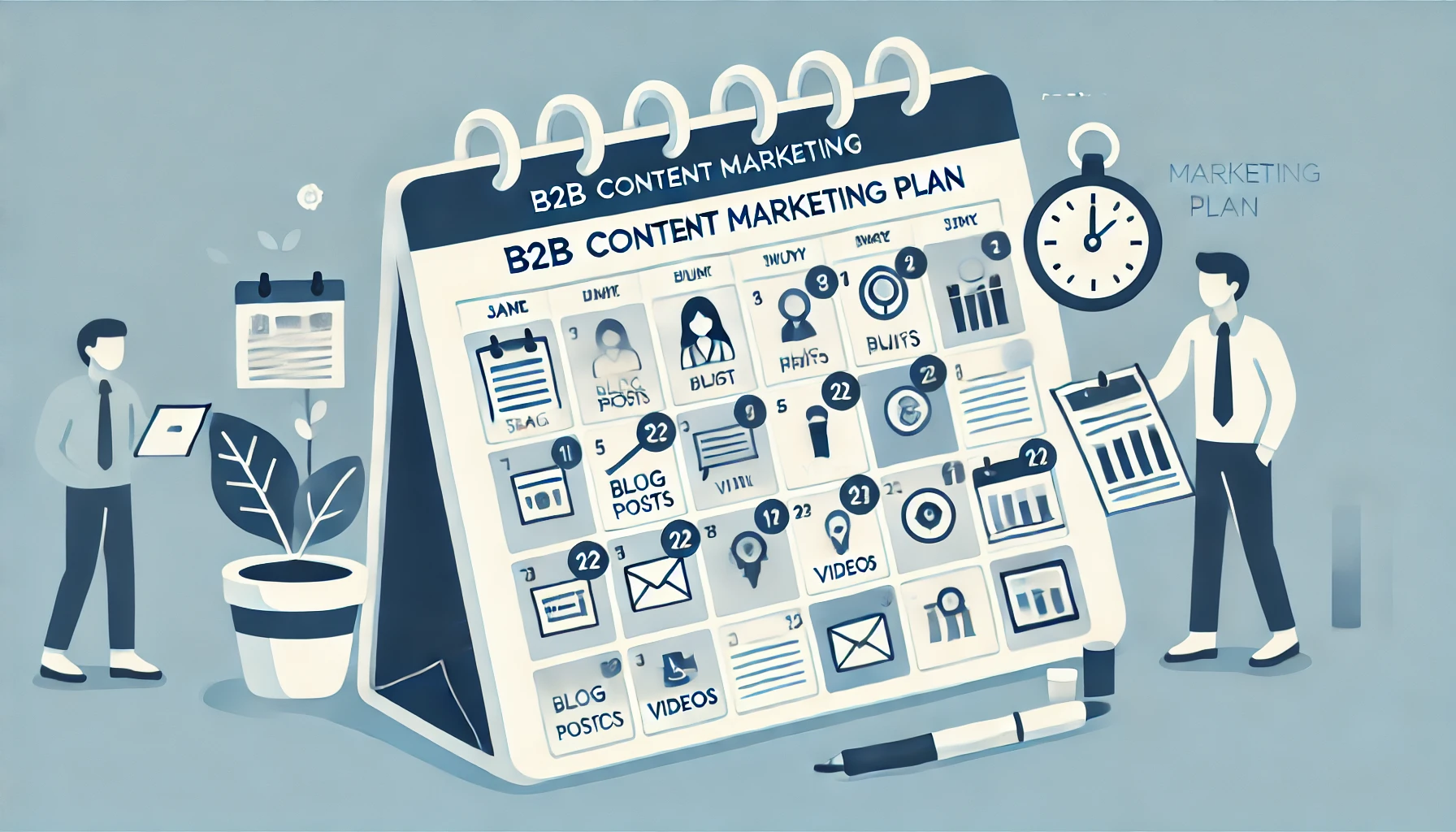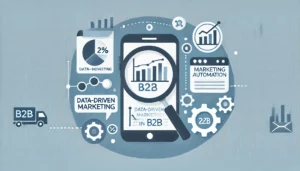How to Create a B2B Content Marketing Plan

Content marketing is a cornerstone of successful B2B marketing strategies. It helps businesses establish thought leadership, build trust with their audience, and generate high-quality leads. Creating an effective content marketing plan is essential for achieving these goals. This blog outlines the key steps to develop a comprehensive B2B content marketing plan that drives results.
Defining Your Goals and Objectives
The first step in creating a content marketing plan is to define your goals and objectives. Understanding what you want to achieve with your content will guide your strategy and help you measure success.
Identifying Key Business Goals
Identify the primary business goals that your content marketing efforts will support. These might include increasing brand awareness, generating leads, nurturing prospects, or driving sales. Aligning your content strategy with your business goals ensures that your efforts contribute to overall business success.
Setting Specific, Measurable Objectives
Set specific, measurable objectives that will help you achieve your business goals. For example, you might aim to increase website traffic by 20%, generate 50 new leads per month, or improve email open rates by 15%. Clear objectives provide direction and enable you to track progress and measure success.
Understanding Your Target Audience
Knowing your target audience is crucial for creating relevant and engaging content. Develop a deep understanding of your audience’s needs, preferences, and pain points to tailor your content accordingly.
Creating Buyer Personas
Create detailed buyer personas that represent your ideal customers. Include information such as demographics, job roles, challenges, and goals. Buyer personas help you visualize your audience and create content that resonates with them.
Analyzing Audience Needs and Pain Points
Conduct research to understand your audience’s needs and pain points. Use surveys, interviews, and social media listening to gather insights. Knowing what your audience cares about allows you to create content that addresses their specific challenges and interests.
Conducting a Content Audit
A content audit helps you assess your existing content and identify gaps and opportunities. It provides a clear picture of what content you have, what’s performing well, and what needs improvement.
Assessing Existing Content
Review your existing content assets, such as blog posts, whitepapers, videos, and case studies. Evaluate their performance based on metrics like traffic, engagement, and conversions. Identify which pieces of content are most effective and why.
Identifying Content Gaps and Opportunities
Identify gaps in your content that need to be filled to meet your audience’s needs and support your business goals. Look for opportunities to update, repurpose, or expand existing content. A thorough content audit helps you make informed decisions about your future content strategy.
Developing a Content Strategy
With a clear understanding of your goals, audience, and existing content, you can develop a content strategy that outlines what content you will create and how you will distribute it.
Choosing Content Types and Formats
Select the types of content that will best engage your audience and achieve your objectives. Common B2B content types include blog posts, whitepapers, ebooks, webinars, case studies, and videos. Diversifying your content formats can help reach different segments of your audience.
Creating a Content Calendar
Develop a content calendar to plan and organize your content production and distribution. A content calendar ensures consistency and helps you stay on track with your publishing schedule. Include key dates, topics, formats, and distribution channels in your calendar.
Creating High-Quality Content
High-quality content is essential for engaging your audience and achieving your marketing goals. Focus on creating content that is valuable, relevant, and well-produced.
Best Practices for Content Creation
Follow best practices for content creation to ensure your content is effective. This includes using clear and concise language, incorporating visuals, and optimizing for SEO. Additionally, ensure your content is well-researched and provides actionable insights for your audience.
Ensuring Consistency and Quality
Maintain consistency in your content’s tone, style, and quality. Develop editorial guidelines that outline your brand voice, formatting preferences, and quality standards. Consistent, high-quality content builds trust and credibility with your audience.
Distributing and Promoting Content
Creating great content is only half the battle; you also need to distribute and promote it effectively. Identify the right channels to reach your audience and develop a promotion strategy to maximize your content’s impact.
Identifying the Right Channels
Select the distribution channels that are most effective for reaching your target audience. Common channels for B2B content include your website, email newsletters, social media platforms, industry forums, and partner websites. Tailor your content for each channel to ensure it resonates with your audience.
Strategies for Content Promotion
Develop a comprehensive promotion strategy to amplify your content’s reach. This might include social media advertising, influencer partnerships, guest blogging, and email marketing. Monitor the performance of your promotion efforts and adjust your strategy as needed to achieve the best results.
Measuring and Analyzing Performance
Measuring the performance of your content marketing efforts is crucial for understanding what’s working and where improvements are needed. Use data and analytics to track your progress and make informed decisions.
Key Metrics to Track
Track key metrics that align with your goals and objectives. Common metrics for B2B content marketing include website traffic, engagement (likes, shares, comments), lead generation, conversion rates, and ROI. These metrics provide insights into the effectiveness of your content and help identify areas for improvement.
Using Analytics to Refine Your Strategy
Regularly analyze your content performance data to refine your strategy. Identify which types of content and topics resonate most with your audience, and adjust your content plan accordingly. Continuous optimization based on data insights ensures that your content marketing efforts remain effective and aligned with your goals.
Adjusting and Optimizing Your Plan
A successful content marketing plan is flexible and adaptable. Be prepared to make adjustments based on performance data, feedback, and changing business objectives.
Making Data-Driven Adjustments
Use the insights gained from your performance analysis to make data-driven adjustments to your content strategy. This might involve shifting focus to high-performing content types, exploring new distribution channels, or updating your content calendar to address emerging trends and topics.
Continuous Improvement and Iteration
Content marketing is an ongoing process that requires continuous improvement and iteration. Regularly review and update your content plan to ensure it remains relevant and effective. Stay informed about industry trends and best practices to keep your content strategy fresh and innovative.
Case Studies of Successful B2B Content Marketing Plans
Examining real-world examples of successful B2B content marketing plans can provide valuable insights and inspiration. Here are a few case studies:
Company A: Driving Lead Generation with Thought Leadership
Company A developed a content marketing plan focused on thought leadership. By consistently publishing high-quality blog posts, whitepapers, and case studies, they established themselves as industry experts. Their content strategy led to a 40% increase in lead generation and a significant boost in brand credibility.
Company B: Enhancing Engagement with Multimedia Content
Company B used a variety of content formats, including videos, webinars, and interactive infographics, to engage their audience. Their content marketing plan included a robust promotion strategy that leveraged social media and email marketing. As a result, they saw a 30% increase in audience engagement and a higher conversion rate from leads to customers.
Company C: Streamlining the Buyer’s Journey with Targeted Content
Company C created a content marketing plan that mapped out the buyer’s journey and provided targeted content for each stage. By addressing the specific needs and questions of their audience at each stage, they streamlined the buyer’s journey and improved their conversion rates. Their data-driven approach to content creation and distribution resulted in a 25% increase in sales.
Conclusion
Creating a B2B content marketing plan involves defining your goals, understanding your audience, conducting a content audit, developing a strategy, creating high-quality content, and measuring performance. By following these steps and continuously optimizing your plan, you can achieve your marketing objectives and drive business growth. Start developing your content marketing plan today to unlock the full potential of your B2B marketing efforts.





